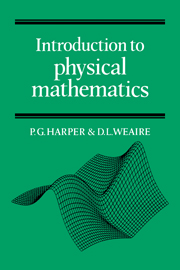Book contents
- Frontmatter
- Contents
- Preface
- Some notes on notation
- 1 Introduction
- 2 Errors
- 3 Cartesian coordinates
- 4 Vectors
- 5 The scalar product
- 6 The vector product and rotation
- 7 Matrices in physics
- 8 The transformation of matrices
- 9 The matrix eigenvalue equation
- 10 Exponential and logarithm functions
- 11 Sine and cosine functions
- 12 Graph plotting and curve sketching
- 13 Differentiation
- 14 Approximations
- 15 Power series and Taylor's expansion
- 16 Partial differentiation
- 17 Integration
- 18 The differential equation
- 19 Solving first-order differential equations
- 20 Second-order differential equations
- 21 Solving second-order differential equations
- 22 The complex exponential
- 23 The circuit equation
- 24 Harmonics and Fourier series
- 25 The diffusion equation
- 26 Waves
- 27 The rate of change of a vector
- 28 The scalar field and gradient operator
- 29 The vector field
- 30 Line integration
- 31 The potential field
- 32 Surface and volume integration
- 33 Flux and divergence
- 34 Circulation and the curl
- 35 Conclusion
- 36 Miscellaneous exercises
- Index
7 - Matrices in physics
Published online by Cambridge University Press: 20 October 2009
- Frontmatter
- Contents
- Preface
- Some notes on notation
- 1 Introduction
- 2 Errors
- 3 Cartesian coordinates
- 4 Vectors
- 5 The scalar product
- 6 The vector product and rotation
- 7 Matrices in physics
- 8 The transformation of matrices
- 9 The matrix eigenvalue equation
- 10 Exponential and logarithm functions
- 11 Sine and cosine functions
- 12 Graph plotting and curve sketching
- 13 Differentiation
- 14 Approximations
- 15 Power series and Taylor's expansion
- 16 Partial differentiation
- 17 Integration
- 18 The differential equation
- 19 Solving first-order differential equations
- 20 Second-order differential equations
- 21 Solving second-order differential equations
- 22 The complex exponential
- 23 The circuit equation
- 24 Harmonics and Fourier series
- 25 The diffusion equation
- 26 Waves
- 27 The rate of change of a vector
- 28 The scalar field and gradient operator
- 29 The vector field
- 30 Line integration
- 31 The potential field
- 32 Surface and volume integration
- 33 Flux and divergence
- 34 Circulation and the curl
- 35 Conclusion
- 36 Miscellaneous exercises
- Index
Summary
As explained in the previous chapters, a physical vector such as a velocity, force or torque is described by its components referred to a fixed set of axes. Three dimensions would be usual but this may be reduced to two in some cases, or even (in relativistic physics) increased to four, reckoning time as a dimension. Also, the idea of a set of variables as constituting a ‘vector’ can be extended to non-geometrical systems whose ‘dimensions’ then refer to the number of degrees of freedom of the system, that is, the number of variables needed to identify what state it is in. Two such vectors may be linearly related through an array of coefficients or matrix. Here we discuss the use and basic properties of matrices, and in the following chapter we outline their more formal manipulation.
An illustration is provided by the analysis of electrical circuits. The standard approach is to regard the circuit as consisting of loops. This requires us to introduce as many currents (as variables) as there are loops. The mathematical connection between the loop voltages and currents can be represented by a square array or matrix of impedance coefficients, as follows.
Consider the 2-loop circuit shown in fig. 7.1. In the left-hand loop a current I1, driven by the battery potential V1, flows through the series resistances R,R1; in the right-hand loop, the current I2 driven by V2 flows through R and R2.
- Type
- Chapter
- Information
- Introduction to Physical Mathematics , pp. 43 - 49Publisher: Cambridge University PressPrint publication year: 1985



